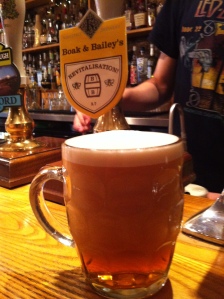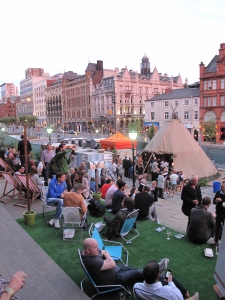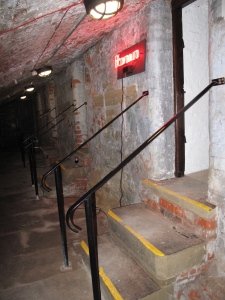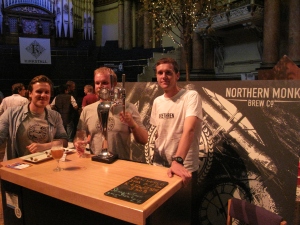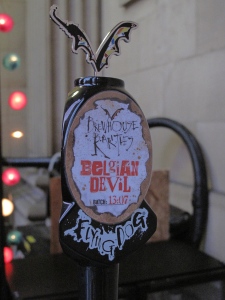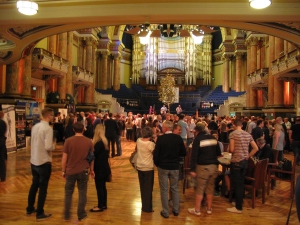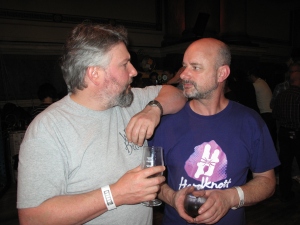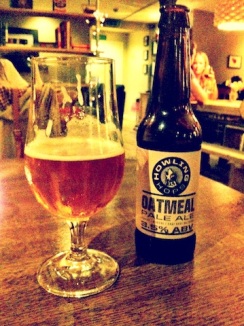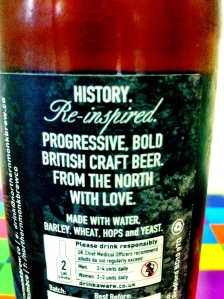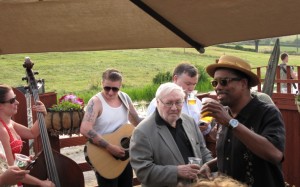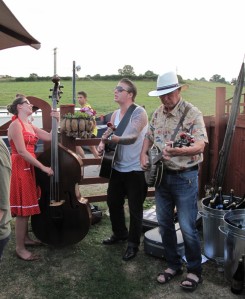The Marshal and Land Of Cartmel – Unsworth’s Yard Brewery, Cartmel, Cumbria
If you’ve seen The Trip or Restaurant Wars: The Battle For Manchester, you’ll be familiar with Simon Rogan and his two-Michelin starred restaurant L’Enclume. L’Enclume is in Cartmel, a village in Cumbria also notable for its sticky toffee puddings and for Rogan’s increasing empire (second restaurant, hotel, pub), which has drawn comparisons with Rick Stein’s impact on Padstow.
L’Enclume deserves its praise, and as a result Cartmel has become a destination for foodies with disposable tuck money. It therefore makes perfect sense to have a microbrewery there and, accordingly, Unsworth’s Yard Brewery was set up in January 2012. In accordance with L’Enclume’s emphasis on local ingredients and suppliers, Unsworth’s Yard’s beers have made it on to the drinks list at the restaurant and are also available in bottle or on cask from the brewery shop, in the village pubs and off licence.
After a very special visit to L’Enclume, I picked up a couple of bottles from Hot Wines to try later. The Land Of Cartmel is a 3.7% pale ale, available in bottles that do not appear to be bottle conditioned. It’s golden, with only a slight hint of coffee in the aroma. It has a good body for a 3.7% bottled beer, which could be down to the wheat in the recipe. There’s a noticeable but not overpowering dry bitterness, tasting a little bit chalky or woody with even a hint of peat at the end. Apart from that last note, it reminded me of both Coniston Bluebird and Butcombe Bitter.
The Marshal presents itself as a bit special. It’s more expensive and comes numbered and dated (this one bottled on 8 October 2013) in a swing-top bottle. A 6% strong pale ale, it has the rich brioche aroma of a Belgian blond. The bitterness is wrapped delicately in a creamy mouthfeel and alcoholic warmth. Once again there’s an earthiness that I would guess is attributable to English hops, although I expect the hop character would be significantly different in a younger bottle. It’s reminiscent of some of the older, southern English breweries’ revivals of their traditional British IPA recipes, but also isn’t a million miles away from Orval (without the Brettanomyces). Like Orval, it would go very well with cheese, perhaps from the cheese shop next door.
Kinnegar Brewing, Rathmullan, County Donegal
The island of Ireland was such a dystopia of beer choice in the early 1970s that a visit inspired four English visitors to band together and form a consumer group to save the remnants of English cask ale when they got back home.
CAMRA lacked significant extraterritorial influence, so cask ale has not had a major resurgence since the 1970s on the island that inspired the campaign. However, as various seasoned Irish bloggers have documented, Ireland has a much more exciting and varied beer culture in the 21st century than it had in the last, but at the same time I didn’t expect a visit to rural Donegal to offer more in the way of beer than Guinness, Guinness or Guinness.
Accordingly, when I last visited Rathmullan for a fishing trip two years ago, there was no evidence of craft beer. But, since then, the small seaside town has acquired its own farmhouse brewery, Kinnegar Brewing, whose beers are available in bottles or on keg in a number of local pubs, including The Beachcomber Bar and The White Harte.
Moreover, Kinnegar seems to be distinguished by a level of quality that most new English breweries fail to achieve. Scraggy Bay IPA in particular is an assertively bitter and citrussy but well-rounded New World-hopped IPA that would hold its own against Jaipur, Punk or Diablo.
After a long day’s fishing off Killybegs, marked by a shortage of actual fish, but the compensation of a pod of dolphins swimming with the boat, I was very happy to sit outside The White Harte, nursing an increasingly red forehead and watching the sun go down over Lough Swilly with a cold glass of a genuinely very good Irish IPA. In the same setting I would have suffered a Guinness too, but still.
Kinnegar’s stockists are listed on its website and include bars and off licences throughout the island, including The Vineyard in Belfast and L Mulligans Grocers in Dublin.
Marks & Spencer Mosaic Pale Ale and Amarillo Golden Ale
It did seem that the craft beer revolution had stopped being able to squeeze into its tight girl jeans and instead had pulled a nice comfy Blue Harbour rugby shirt over its growing paunch when Marks and Spencer started selling single-hopped beers, but Oakham Citra under M&S branding being so widely available to the poor huddled middle classes should not be shrugged at. The other beers (Elgood’s Sovereign, Crouch Vale’s Hallertau Brewers Gold and Castle Rock’s Cascade) were each interesting enough, but none were as well-rounded or exciting as Citra, which qualifies as a modern classic.
It seems that the initial experiment was successful enough for M&S to ask for more single-hopped beers from their favoured English breweries, and two new bottles, Mosaic Pale Ale from Adnams and Amarillo Golden Ale from Meantime, caught my eye this week.
Both breweries have had good-to-excellent form in their previous offerings for M&S. Adnam’s Summer IPA and Winter IPA (rebadging their American Style IPA and Innovation respectively) are two of the most enjoyable beers that Marks and Spencer have stocked, and it seemed doubly bold of M&S to stock hoppy beers that exceeded 6%. I was less convinced by the rebadged Sole Star, but it was acceptable for a tax-efficient 2.7%. Meantime’s more expensive barrel-aged offerings have been less successful, but their Black IPA was solid, even if black IPA in M&S feels like Motörhead t-shirts in New Look.
Moving on to the new beers, Adnam’s Mosaic Pale Ale is copper blonde in colour with a slightly metallic aroma. The overall impression from the first taste is a thin mouthfeel and restrained dry bitterness without much depth. The metallic taste builds into a more rounded bitterness, but one characterised by that oniony quality that you get from Simcoe (from which Mosaic is derived). It’s a more pleasant drink than that sounds, perhaps one that will appeal to Brewdog fans given their signature use of Simcoe and which might go well with barbecued red meat.
The Meantime-brewed Amarillo Golden Ale is another story altogether: it’s straw coloured with a whiter, frothier head. A fuller, oilier mouthfeel sustains the flavours of apricots and flowers, with a little grapefruit. A more elegant beer than the Mosaic and an easier one to love, it would go well with light, spicy foods and mango salsa.
Both are pretty good for the barbecue season then, but I would recommend the Amarillo and the still-available Citra if your tastes are similar to mine.
Good Vibrations and Bad Vibes: Amateur criticism and social media
I recently read a Facebook post that appeared to be by Belfast record shop owner and label starter Terri Hooley. The post drew attention to a mini-review of the film of his life, Good Vibrations. The review was on a site called “Letterboxd” (a social networking/microblogging site for film fans) and only said:
The ultimate proof (if any more was needed after he put Saving Mr. Banks on his year-end top 10 list) that Mark Kermode has become an old, whiny, out-of-touch, middlebrow and sentimental fart.
Mark Kermode had named Good Vibrations, which is a lovely low budget film based on Terri’s own anecdotes about the liberating effect of punk on himself and the teenagers living through the worst of the Troubles in Northern Ireland, as one of the best of last year. In the Facebook post, Terri was angry about Mark suffering the “backlash” that he had expected from the film but hadn’t yet experienced.
Good Vibrations is not flawless as films go, not least because of its limited budget, but most people will find themselves swept along in its humour and amiability and appreciate Terri’s fundamental rightness in supporting music’s redemptive effect in a situation sorely lacking in redemption; a Northern Irish Twenty Four Hour Party People with less knowing playfulness but higher stakes.
But there will be exceptions and, in 2014, some of those people will decide to tell the internet when they didn’t like it. When they decide to do so, they will tend not to consider the possibility that someone who invested more in the end product than the cost of an online rental might read it. Like Terri, for example, for whom it is essentially the end product of his entire life, along with introducing John Peel to the Undertones (and selling me a Frank Zappa bootleg 14 years ago).
The reason that I’m writing this on a near-defunct beer blog is that it reminds me of the situation regarding beer. The craft beer industry is full of people who have a really close connection to their product, take pride in their work, will be genuinely hurt by online criticism and consequently annoyed by it, especially when that criticism comes from people who appear not to know what they’re talking about. Except it is also the case that the people who are criticising them aren’t usually claiming to express an expert opinion, but are merely venting the feeling that they didn’t get value for money from the beer they bought, which might have been an actual problem of quality, a misunderstanding about what the brewer was trying to achieve or possibly even an utter failure of palate.
I am in no position to criticise a brewer for what they are trying to do when occasionally they fail to achieve it, and consequently don’t have a lot to say these days. I would be more willing to criticise a larger brewery for trying to piggy-back on the shoulders of many smaller brewers and launching “craft beers” that merely devalue that already-amorphous term, if the whole situation didn’t fill me with inertia.
But, I suppose, if there is a moral to be taken for brewers it is to listen to individual criticisms, be open to their validity, but also be prepared to dismiss them graciously and/or silently if they obviously have no merit. The product will, over time, probably speak for itself. The risk of the alternative is to be Ricky Gervais, railing against “critics” and turning everyone else against you in the process.
Finally, I would recommend that you watch Good Vibrations. It’s a craft film if ever there was one.
Wolf In Sheep’s Clothing: Howling Hops Oatmeal Pale Ale (3.5% ABV)
“3.5%” on a bottle label can be a depressing thing for the drinker to see. If I know nothing else about a beer other than the ABV, if I see 3.5% I assume I’m in for something lacking in excitement. A mild. The most boring of brown bitters. A thin stout. Even where “New World hops” are advertised, you wonder if they wouldn’t rather be starring in something better, like a respected actor taking roles in artless films to pay a tax debt.
There’s a small number of good examples of New World-hopped low ABV beers, but most are primarily cask beers and don’t carry over well to bottles, if they even try. In particular they feel thin and dry, which can be fine, but not if you have a taste for big oily, sticky American IPAs. I’ve yet to try a passable 2.8% pale ale.
But sometimes you need something tasty in a bottle which will not challenge your sobriety. For that I recommend Howling Hops Oatmeal Pale Ale. I know, it sounds awful: 3.5% porridge pale. An albino oatmeal stout. From Hackney, no less. But instead, what you get is a crisp citrus-hopped beer with a remarkable amount of body, and if you didn’t know better you might place it somewhere north of 5.5%.
I assume it’s down to the oatmeal. If it is, perhaps oatmeal is the magic bullet for low ABV pale ales. If it isn’t – and remember that I know less about the science of brewing than most people reading this – forget all of the above. It’s still a really good little beer.
Brave New World: Northern Monk Brew Co New World IPA (6.2% ABV)
Craft beer has recently become, if not ubiquitous or always readily available, then certainly a trend of which people are increasingly aware. There are a number of examples of mainstream breweries and retailers, with varying success, attempting to capitalise on that popularity. There are also some new breweries that, on closer inspection, give the impression that they don’t quite “get” what is special about craft, but think that the concept might sell.
Against that context, and admitting that craft is an amorphous concept at the best of times, it might be easy to overlook genuinely interesting new breweries in all the noise. However, even before trying any of their beers, I was already reasonably confident that Northern Monk Brew Co would subscribe to my own concept of craft because of the involvement of David Bishop, familiar to beer blog readers and Tweeters as keen homebrewer and blogger @broadfordbrewer. You can read about David being approached by a prospective business partner and his progress with the brewery on his blog. You can also read an interview with co-founder Russell on This Beer Blog.
Their first beer is an IPA which was brewed in cuckoo/gypsy manner at Hambleton, which will be the provisional arrangement, along with some interesting collaborations, before an actual Northern Monk brewery is complete. Northern Monk had a launch party last week at The Sparrow in Bradford. I wasn’t able to attend, but did pick up a couple of bottles from Friends Of Ham in Leeds.
IPA is basically the core craft style and I’m happy to say that New World IPA is a great example of what it is intended to be. The first impression is excellent, with a lovely fresh aroma of pine and apricots. The taste is well-balanced, with a nice mix of fruity sweetness and a good lasting bitterness. It’s tasty but not so characterful that it wouldn’t seem “sessionable”, which could be a little dangerous for a 6.2% beer that doesn’t come across as that strong.
Regarding his short term ambitions, David has said:
So what do I want to achieve? I want to support my family and I want to do that by getting paid to do the thing that interests and excites me: brewing beer. How I go about doing that is also important to me and I need a game plan. Over to Stuart:
“The apparent conflict between idiosyncrasy and balance brings me to the question which I ask myself today. Am I trying to get a number one single or win the Turner Prize? Does there need to be a compromise?”
As a brewer just starting out I want to brew decent, tasty beer. I want the beer to be good enough to allow us to brew a second beer and so on. Don’t get me wrong, I want to do the best I can, but I’m not aspiring for a number one single. Not yet!
So now that we have that first beer, it’s gratifying that it tastes good, the branding looks good and the blurb is refreshingly free of utter marketing bollocks – the reality is that for a new brewery the branding is probably almost as important as the beer. The bottle isn’t covered in geeky detail about ingredients and IBUs but that’s all on the website.
On this evidence I’m very happy to say that Northern Monk’s first beer is more than good enough to ensure that people come back for the second. I very much hope that they do, not just because I like David and want him to make a living doing what he loves, but because, more selfishly, I want to drink more of his beer.
See another (better) review of New World IPA on Booze, Beats and Bites. Details of the first places that you might find Northern Monk beers in bottles and on keg are on their Twitter (@NMBCo) and Facebook pages.
Brooklyn Brewery Pop Up, 20-24 The Calls, Leeds City Centre
James Clay, importer of some of the best American, Belgian and German beers to the UK, have succeeded in an application for a licence to open a “pop up” Brooklyn Brewery bar in a warehouse on The Calls in central Leeds, despite police objections.
The bar will be in a currently empty warehouse at 20-24 The Calls, about 50 metres from BrewDog Leeds and 100 metres from The Stew & Oyster (Calls Landing). The licence application documents, which can be read here, show similar objections from the police as were made in the BrewDog licensing saga, to opening any new bar close to “an area which is an alcohol related crime hotspot, Call Lane” and the same “appreciation versus inebriation” arguments.
The Yorkshire Evening Post reports that representations were made to the sub-committee that the bar was to attract, “the well-behaved and “discerning” drinker, prepared to spend £7 or more on a pint of speciality beer“. A representative of the West Yorkshire Police stated that, “People with money still have the ability of causing trouble when inebriated.” Surely not.
The bar is stated to be temporary, although it is not clear for how long it is expected to operate. The licence is restricted to Wednesdays, Thursdays, Saturdays and Sundays. Interestingly, it was stated that the bar is “a temporary arts and cultural space used for the purpose of marketing“, that it is primarily an exercise in promoting the Brooklyn brand and may operate at a loss. However, at £7+ a pint I assume the loss won’t be made on the beer.
I’ll be interested to see how this pans out and whether the set-up will offer something different to the existing craft beer bars in Leeds. When I read about it, I initially thought of the regular Friday evening “happy hour” sessions held in the brewery in Williamsburg when we went there in 2010 (see photo), with picnic tables, plastic glasses, beer vouchers, pizzas delivered to the front door and ultraobscure beers. I assume that this new venture, “pop up” as it is, will seem a little more permanent, but who knows? Spit and sawdust can be pretty hip.
